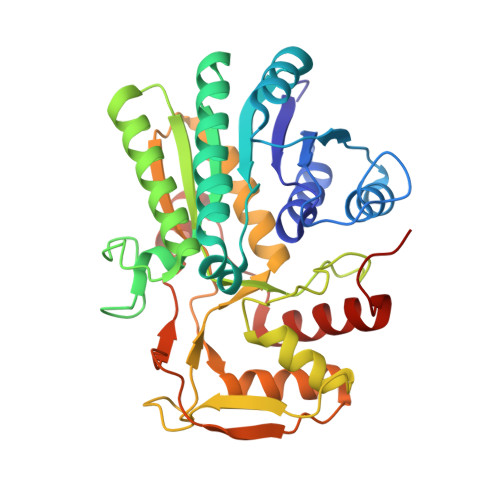Crystallographic evidence for Tyr 157 functioning as the active site base in human UDP-galactose 4-epimerase.
Thoden, J.B., Wohlers, T.M., Fridovich-Keil, J.L., Holden, H.M.(2000) Biochemistry 39: 5691-5701
- PubMed: 10801319
- DOI: https://doi.org/10.1021/bi000215l
- Primary Citation of Related Structures:
1EK5, 1EK6 - PubMed Abstract:
UDP-galactose 4-epimerase catalyzes the interconversion of UDP-glucose and UDP-galactose during normal galactose metabolism. In humans, deficiencies in this enzyme lead to the complex disorder referred to as epimerase-deficiency galactosemia. Here, we describe the high-resolution X-ray crystallographic structures of human epimerase in the resting state (i.e., with bound NAD(+)) and in a ternary complex with bound NADH and UDP-glucose. Those amino acid side chains responsible for anchoring the NAD(+) to the protein include Asp 33, Asn 37, Asp 66, Tyr 157, and Lys 161. The glucosyl group of the substrate is bound to the protein via the side-chain carboxamide groups of Asn 187 and Asn 207. Additionally, O(gamma) of Ser 132 and O(eta) of Tyr 157 lie within 2.4 and 3.1 A, respectively, of the 4'-hydroxyl group of the sugar. Comparison of the polypeptide chains for the resting enzyme and for the protein with bound NADH and UDP-glucose demonstrates that the major conformational changes which occur upon substrate binding are limited primarily to the regions defined by Glu 199 to Asp 240 and Gly 274 to Tyr 308. Additionally, this investigation reveals for the first time that a conserved tyrosine, namely Tyr 157, is in the proper position to interact directly with the 4'-hydroxyl group of the sugar substrate and to thus serve as the active-site base. A low barrier hydrogen bond between the 4'-hydroxyl group of the sugar and O(gamma) of Ser 132 facilitates proton transfer from the sugar 4'-hydroxyl group to O(eta) of Tyr 157.
Organizational Affiliation:
Department of Biochemistry, University of Wisconsin, Madison, Wisconsin 53705, USA.















